Factors Influencing Tertiary Employees' Investment Decisions
VerifiedAdded on 2021/05/27
|11
|2671
|55
Report
AI Summary
This report examines the investment choices available to tertiary employees, focusing on defined benefit plans and investment choice plans. It explores the impact of various economic factors, including interest rates, purchasing power, inflation, and balance of trade, on investment decisions. The report highlights the importance of considering risk tolerance, time value of money, and tax implications when selecting investment options. It emphasizes that employees should align their investment choices with their risk appetite and financial goals, and that tax benefits can significantly influence investment outcomes. The analysis also covers the significance of accurate estimations in defined benefit plans and provides recommendations for tertiary employees to optimize their investment strategies based on their individual circumstances and market conditions. The report concludes that strategic financial planning is essential for maximizing investment returns and achieving financial security.
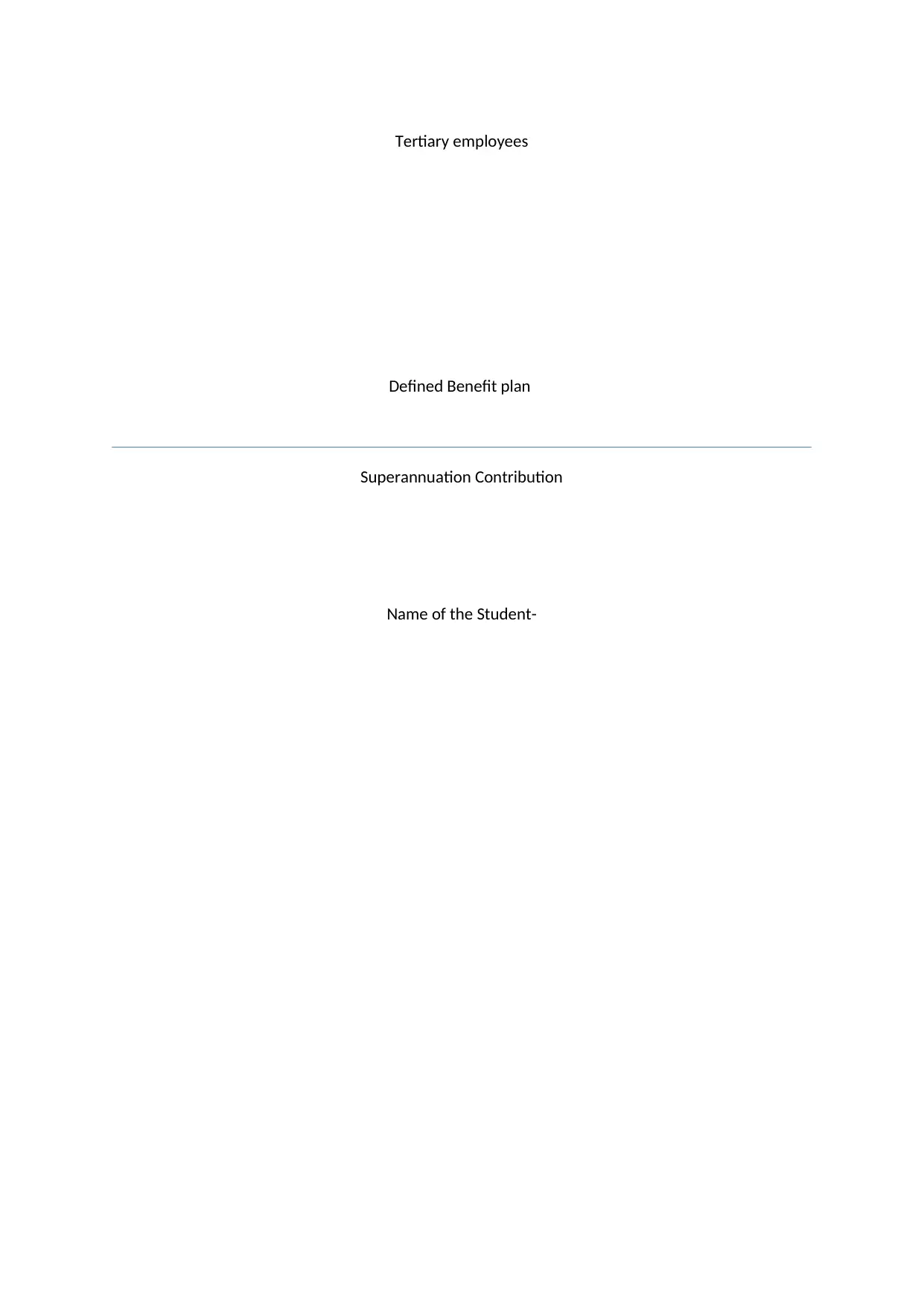
Tertiary employees
Defined Benefit plan
Superannuation Contribution
Name of the Student-
Defined Benefit plan
Superannuation Contribution
Name of the Student-
Paraphrase This Document
Need a fresh take? Get an instant paraphrase of this document with our AI Paraphraser
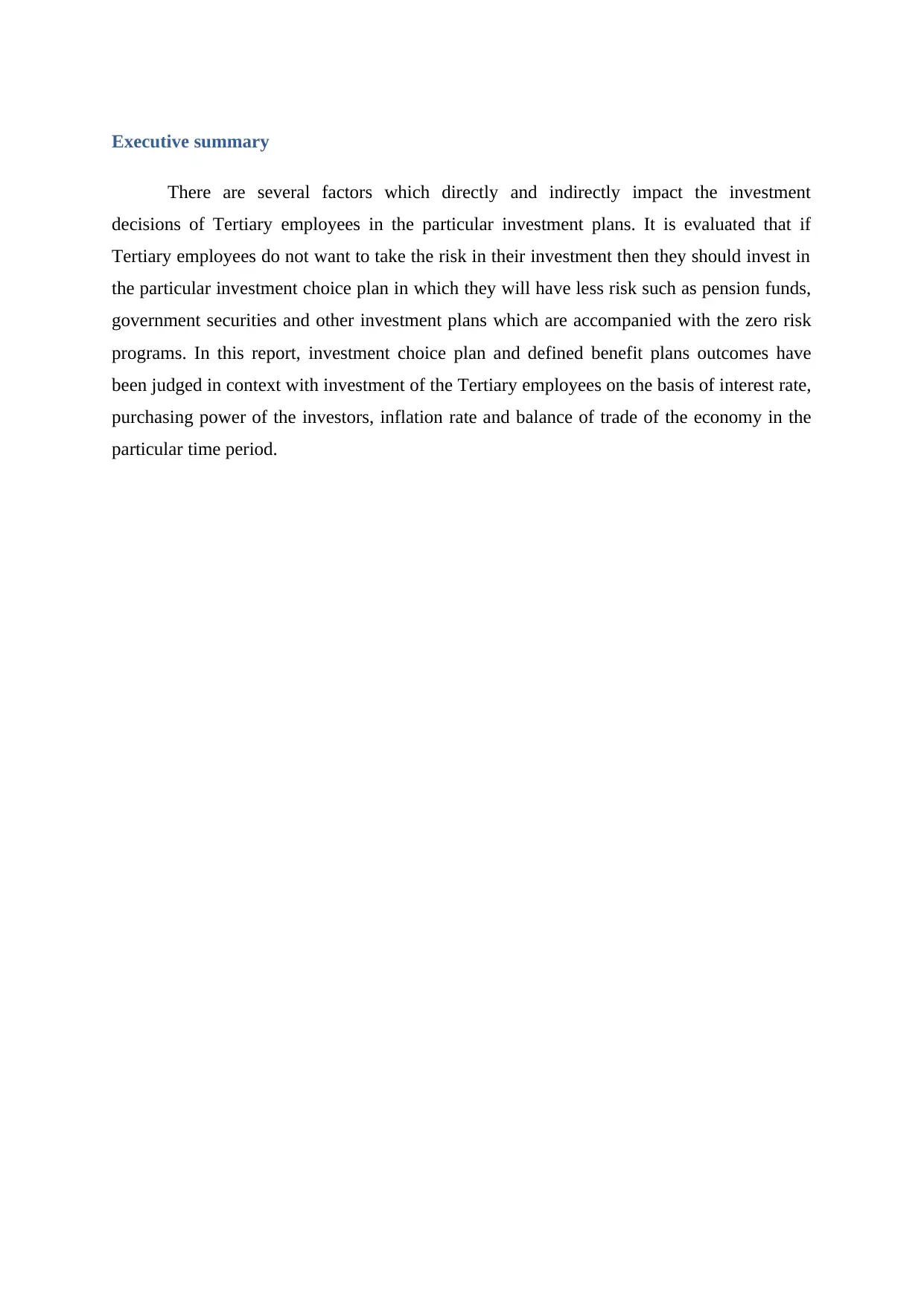
Executive summary
There are several factors which directly and indirectly impact the investment
decisions of Tertiary employees in the particular investment plans. It is evaluated that if
Tertiary employees do not want to take the risk in their investment then they should invest in
the particular investment choice plan in which they will have less risk such as pension funds,
government securities and other investment plans which are accompanied with the zero risk
programs. In this report, investment choice plan and defined benefit plans outcomes have
been judged in context with investment of the Tertiary employees on the basis of interest rate,
purchasing power of the investors, inflation rate and balance of trade of the economy in the
particular time period.
There are several factors which directly and indirectly impact the investment
decisions of Tertiary employees in the particular investment plans. It is evaluated that if
Tertiary employees do not want to take the risk in their investment then they should invest in
the particular investment choice plan in which they will have less risk such as pension funds,
government securities and other investment plans which are accompanied with the zero risk
programs. In this report, investment choice plan and defined benefit plans outcomes have
been judged in context with investment of the Tertiary employees on the basis of interest rate,
purchasing power of the investors, inflation rate and balance of trade of the economy in the
particular time period.
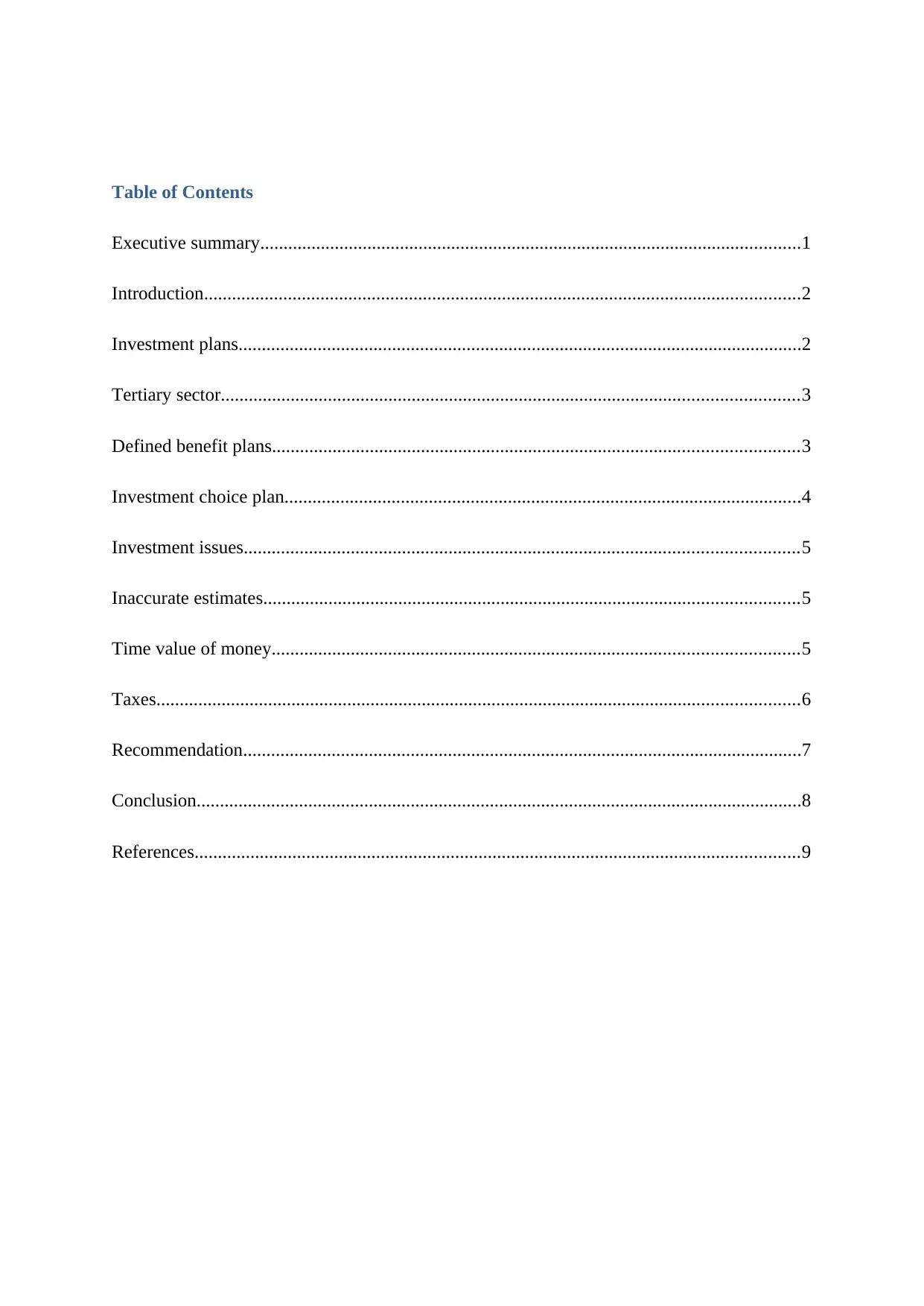
Table of Contents
Executive summary....................................................................................................................1
Introduction................................................................................................................................2
Investment plans.........................................................................................................................2
Tertiary sector............................................................................................................................3
Defined benefit plans.................................................................................................................3
Investment choice plan...............................................................................................................4
Investment issues.......................................................................................................................5
Inaccurate estimates...................................................................................................................5
Time value of money.................................................................................................................5
Taxes..........................................................................................................................................6
Recommendation........................................................................................................................7
Conclusion..................................................................................................................................8
References..................................................................................................................................9
Executive summary....................................................................................................................1
Introduction................................................................................................................................2
Investment plans.........................................................................................................................2
Tertiary sector............................................................................................................................3
Defined benefit plans.................................................................................................................3
Investment choice plan...............................................................................................................4
Investment issues.......................................................................................................................5
Inaccurate estimates...................................................................................................................5
Time value of money.................................................................................................................5
Taxes..........................................................................................................................................6
Recommendation........................................................................................................................7
Conclusion..................................................................................................................................8
References..................................................................................................................................9
⊘ This is a preview!⊘
Do you want full access?
Subscribe today to unlock all pages.

Trusted by 1+ million students worldwide
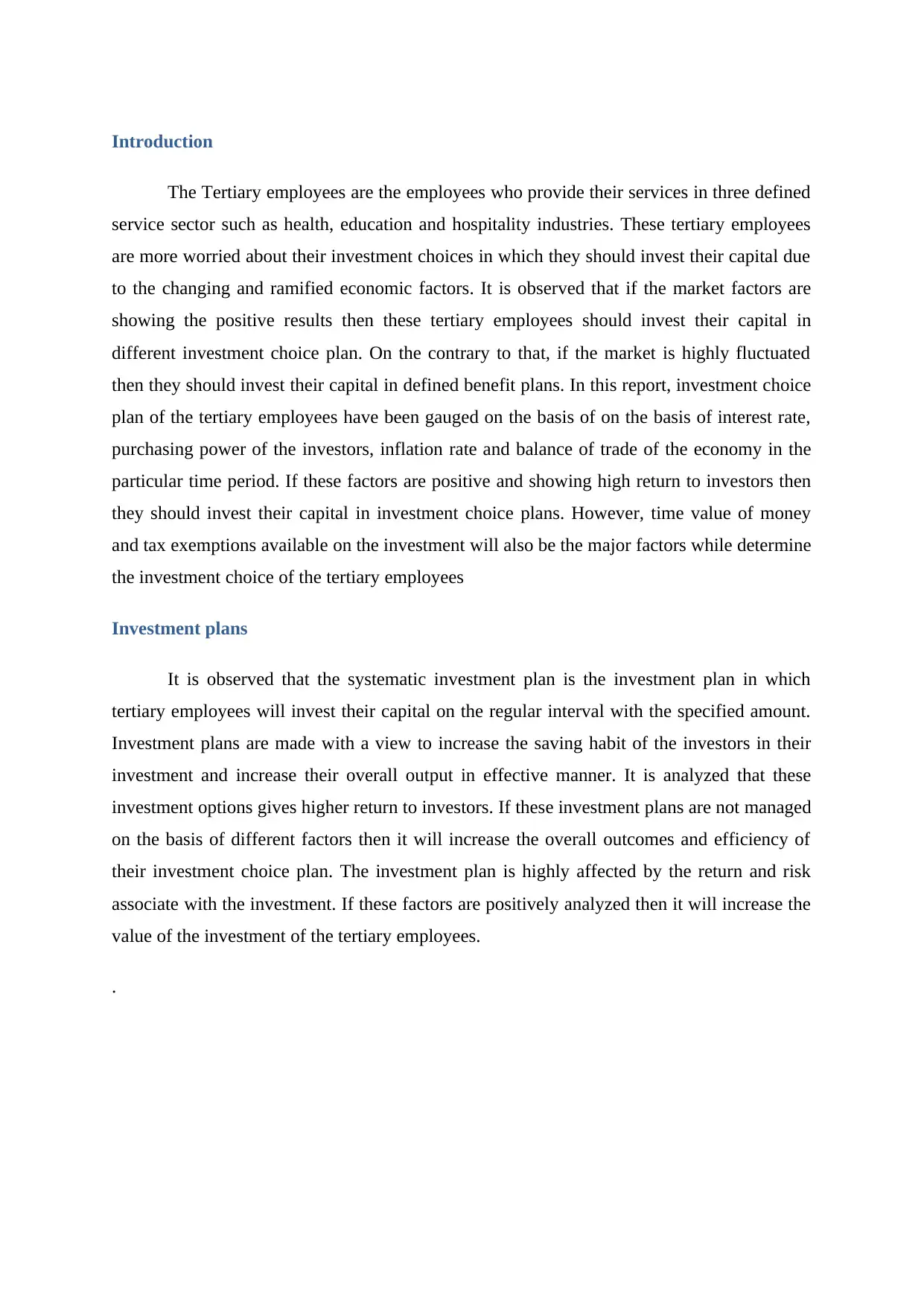
Introduction
The Tertiary employees are the employees who provide their services in three defined
service sector such as health, education and hospitality industries. These tertiary employees
are more worried about their investment choices in which they should invest their capital due
to the changing and ramified economic factors. It is observed that if the market factors are
showing the positive results then these tertiary employees should invest their capital in
different investment choice plan. On the contrary to that, if the market is highly fluctuated
then they should invest their capital in defined benefit plans. In this report, investment choice
plan of the tertiary employees have been gauged on the basis of on the basis of interest rate,
purchasing power of the investors, inflation rate and balance of trade of the economy in the
particular time period. If these factors are positive and showing high return to investors then
they should invest their capital in investment choice plans. However, time value of money
and tax exemptions available on the investment will also be the major factors while determine
the investment choice of the tertiary employees
Investment plans
It is observed that the systematic investment plan is the investment plan in which
tertiary employees will invest their capital on the regular interval with the specified amount.
Investment plans are made with a view to increase the saving habit of the investors in their
investment and increase their overall output in effective manner. It is analyzed that these
investment options gives higher return to investors. If these investment plans are not managed
on the basis of different factors then it will increase the overall outcomes and efficiency of
their investment choice plan. The investment plan is highly affected by the return and risk
associate with the investment. If these factors are positively analyzed then it will increase the
value of the investment of the tertiary employees.
.
The Tertiary employees are the employees who provide their services in three defined
service sector such as health, education and hospitality industries. These tertiary employees
are more worried about their investment choices in which they should invest their capital due
to the changing and ramified economic factors. It is observed that if the market factors are
showing the positive results then these tertiary employees should invest their capital in
different investment choice plan. On the contrary to that, if the market is highly fluctuated
then they should invest their capital in defined benefit plans. In this report, investment choice
plan of the tertiary employees have been gauged on the basis of on the basis of interest rate,
purchasing power of the investors, inflation rate and balance of trade of the economy in the
particular time period. If these factors are positive and showing high return to investors then
they should invest their capital in investment choice plans. However, time value of money
and tax exemptions available on the investment will also be the major factors while determine
the investment choice of the tertiary employees
Investment plans
It is observed that the systematic investment plan is the investment plan in which
tertiary employees will invest their capital on the regular interval with the specified amount.
Investment plans are made with a view to increase the saving habit of the investors in their
investment and increase their overall output in effective manner. It is analyzed that these
investment options gives higher return to investors. If these investment plans are not managed
on the basis of different factors then it will increase the overall outcomes and efficiency of
their investment choice plan. The investment plan is highly affected by the return and risk
associate with the investment. If these factors are positively analyzed then it will increase the
value of the investment of the tertiary employees.
.
Paraphrase This Document
Need a fresh take? Get an instant paraphrase of this document with our AI Paraphraser
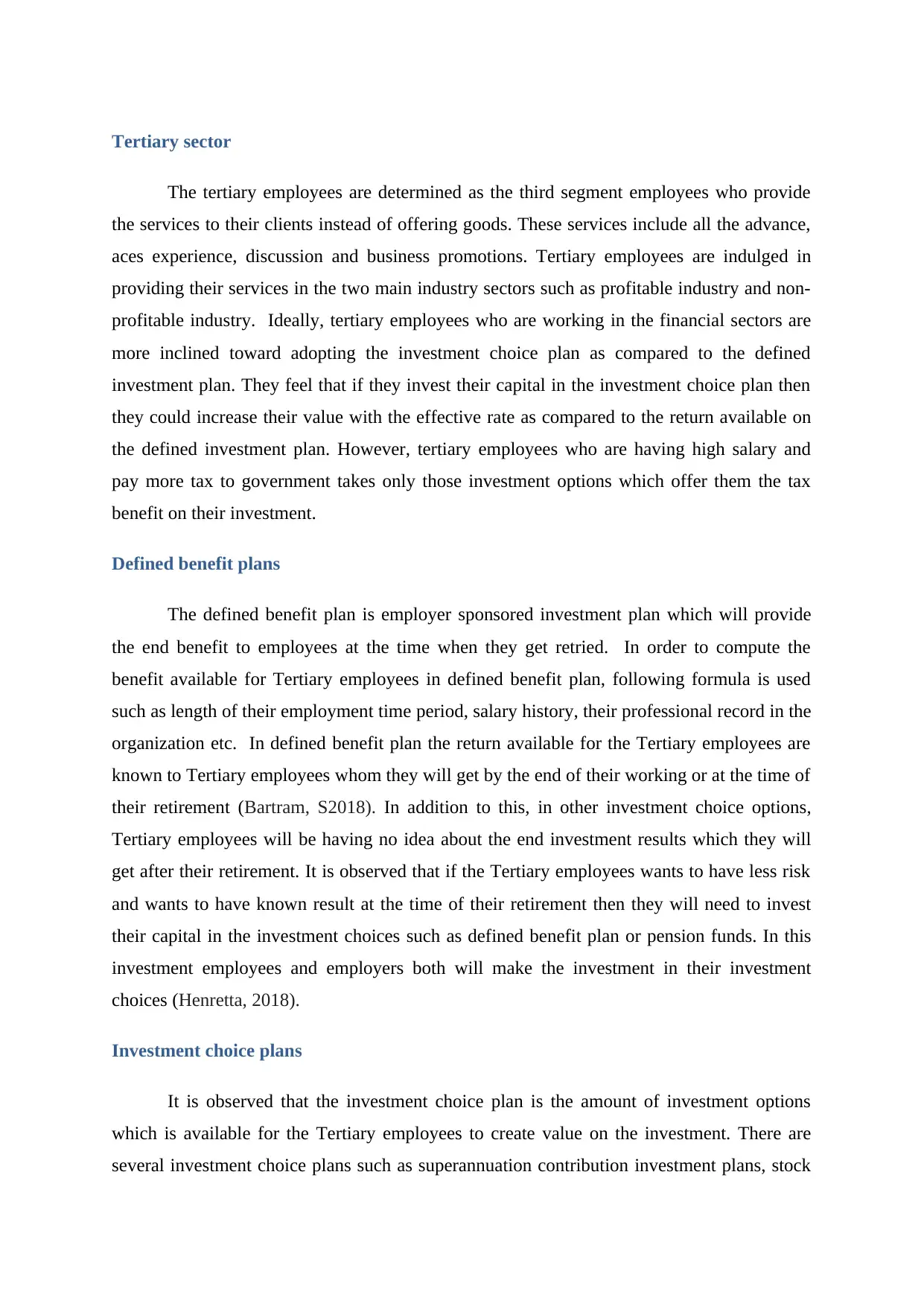
Tertiary sector
The tertiary employees are determined as the third segment employees who provide
the services to their clients instead of offering goods. These services include all the advance,
aces experience, discussion and business promotions. Tertiary employees are indulged in
providing their services in the two main industry sectors such as profitable industry and non-
profitable industry. Ideally, tertiary employees who are working in the financial sectors are
more inclined toward adopting the investment choice plan as compared to the defined
investment plan. They feel that if they invest their capital in the investment choice plan then
they could increase their value with the effective rate as compared to the return available on
the defined investment plan. However, tertiary employees who are having high salary and
pay more tax to government takes only those investment options which offer them the tax
benefit on their investment.
Defined benefit plans
The defined benefit plan is employer sponsored investment plan which will provide
the end benefit to employees at the time when they get retried. In order to compute the
benefit available for Tertiary employees in defined benefit plan, following formula is used
such as length of their employment time period, salary history, their professional record in the
organization etc. In defined benefit plan the return available for the Tertiary employees are
known to Tertiary employees whom they will get by the end of their working or at the time of
their retirement (Bartram, S2018). In addition to this, in other investment choice options,
Tertiary employees will be having no idea about the end investment results which they will
get after their retirement. It is observed that if the Tertiary employees wants to have less risk
and wants to have known result at the time of their retirement then they will need to invest
their capital in the investment choices such as defined benefit plan or pension funds. In this
investment employees and employers both will make the investment in their investment
choices (Henretta, 2018).
Investment choice plans
It is observed that the investment choice plan is the amount of investment options
which is available for the Tertiary employees to create value on the investment. There are
several investment choice plans such as superannuation contribution investment plans, stock
The tertiary employees are determined as the third segment employees who provide
the services to their clients instead of offering goods. These services include all the advance,
aces experience, discussion and business promotions. Tertiary employees are indulged in
providing their services in the two main industry sectors such as profitable industry and non-
profitable industry. Ideally, tertiary employees who are working in the financial sectors are
more inclined toward adopting the investment choice plan as compared to the defined
investment plan. They feel that if they invest their capital in the investment choice plan then
they could increase their value with the effective rate as compared to the return available on
the defined investment plan. However, tertiary employees who are having high salary and
pay more tax to government takes only those investment options which offer them the tax
benefit on their investment.
Defined benefit plans
The defined benefit plan is employer sponsored investment plan which will provide
the end benefit to employees at the time when they get retried. In order to compute the
benefit available for Tertiary employees in defined benefit plan, following formula is used
such as length of their employment time period, salary history, their professional record in the
organization etc. In defined benefit plan the return available for the Tertiary employees are
known to Tertiary employees whom they will get by the end of their working or at the time of
their retirement (Bartram, S2018). In addition to this, in other investment choice options,
Tertiary employees will be having no idea about the end investment results which they will
get after their retirement. It is observed that if the Tertiary employees wants to have less risk
and wants to have known result at the time of their retirement then they will need to invest
their capital in the investment choices such as defined benefit plan or pension funds. In this
investment employees and employers both will make the investment in their investment
choices (Henretta, 2018).
Investment choice plans
It is observed that the investment choice plan is the amount of investment options
which is available for the Tertiary employees to create value on the investment. There are
several investment choice plans such as superannuation contribution investment plans, stock
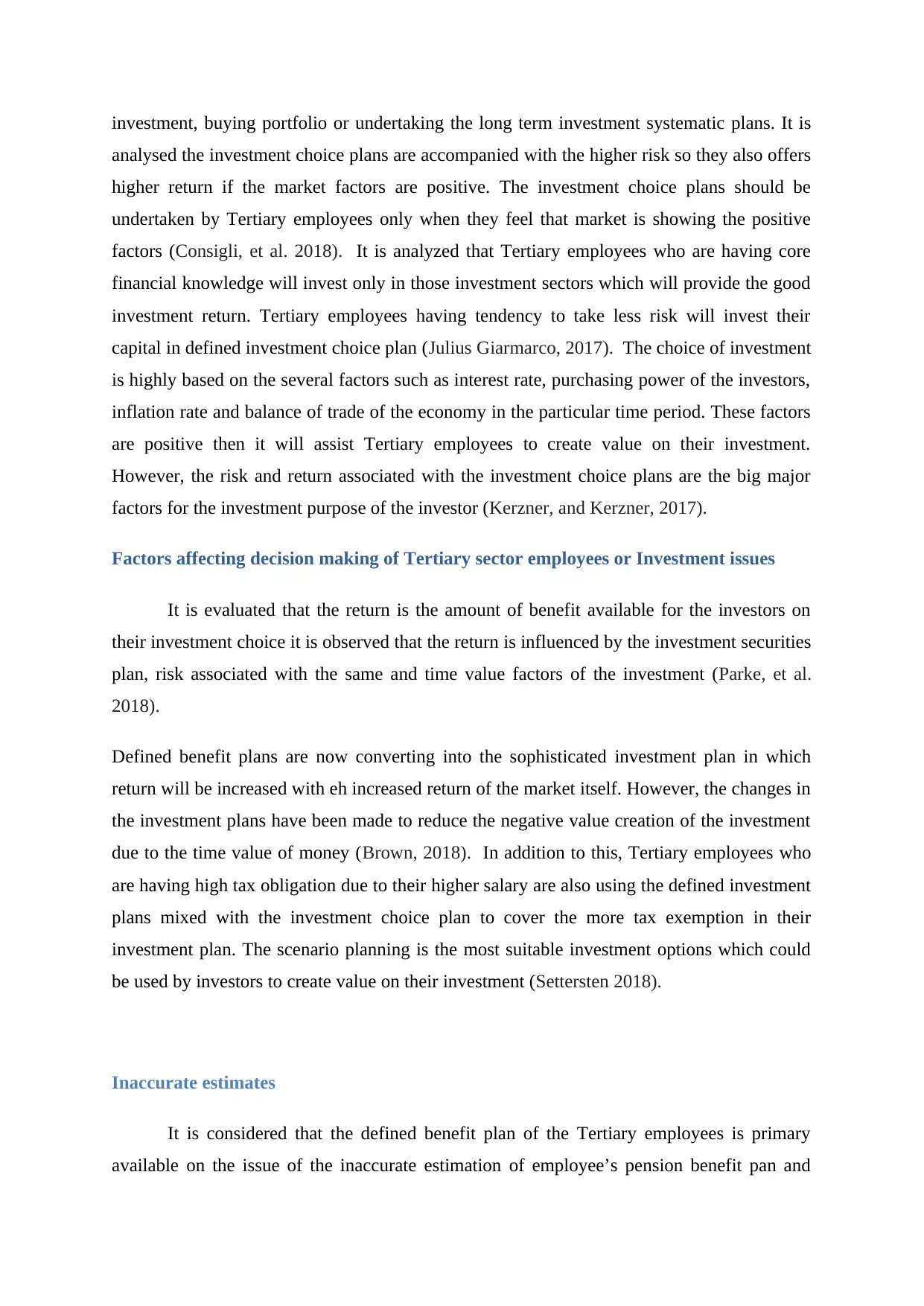
investment, buying portfolio or undertaking the long term investment systematic plans. It is
analysed the investment choice plans are accompanied with the higher risk so they also offers
higher return if the market factors are positive. The investment choice plans should be
undertaken by Tertiary employees only when they feel that market is showing the positive
factors (Consigli, et al. 2018). It is analyzed that Tertiary employees who are having core
financial knowledge will invest only in those investment sectors which will provide the good
investment return. Tertiary employees having tendency to take less risk will invest their
capital in defined investment choice plan (Julius Giarmarco, 2017). The choice of investment
is highly based on the several factors such as interest rate, purchasing power of the investors,
inflation rate and balance of trade of the economy in the particular time period. These factors
are positive then it will assist Tertiary employees to create value on their investment.
However, the risk and return associated with the investment choice plans are the big major
factors for the investment purpose of the investor (Kerzner, and Kerzner, 2017).
Factors affecting decision making of Tertiary sector employees or Investment issues
It is evaluated that the return is the amount of benefit available for the investors on
their investment choice it is observed that the return is influenced by the investment securities
plan, risk associated with the same and time value factors of the investment (Parke, et al.
2018).
Defined benefit plans are now converting into the sophisticated investment plan in which
return will be increased with eh increased return of the market itself. However, the changes in
the investment plans have been made to reduce the negative value creation of the investment
due to the time value of money (Brown, 2018). In addition to this, Tertiary employees who
are having high tax obligation due to their higher salary are also using the defined investment
plans mixed with the investment choice plan to cover the more tax exemption in their
investment plan. The scenario planning is the most suitable investment options which could
be used by investors to create value on their investment (Settersten 2018).
Inaccurate estimates
It is considered that the defined benefit plan of the Tertiary employees is primary
available on the issue of the inaccurate estimation of employee’s pension benefit pan and
analysed the investment choice plans are accompanied with the higher risk so they also offers
higher return if the market factors are positive. The investment choice plans should be
undertaken by Tertiary employees only when they feel that market is showing the positive
factors (Consigli, et al. 2018). It is analyzed that Tertiary employees who are having core
financial knowledge will invest only in those investment sectors which will provide the good
investment return. Tertiary employees having tendency to take less risk will invest their
capital in defined investment choice plan (Julius Giarmarco, 2017). The choice of investment
is highly based on the several factors such as interest rate, purchasing power of the investors,
inflation rate and balance of trade of the economy in the particular time period. These factors
are positive then it will assist Tertiary employees to create value on their investment.
However, the risk and return associated with the investment choice plans are the big major
factors for the investment purpose of the investor (Kerzner, and Kerzner, 2017).
Factors affecting decision making of Tertiary sector employees or Investment issues
It is evaluated that the return is the amount of benefit available for the investors on
their investment choice it is observed that the return is influenced by the investment securities
plan, risk associated with the same and time value factors of the investment (Parke, et al.
2018).
Defined benefit plans are now converting into the sophisticated investment plan in which
return will be increased with eh increased return of the market itself. However, the changes in
the investment plans have been made to reduce the negative value creation of the investment
due to the time value of money (Brown, 2018). In addition to this, Tertiary employees who
are having high tax obligation due to their higher salary are also using the defined investment
plans mixed with the investment choice plan to cover the more tax exemption in their
investment plan. The scenario planning is the most suitable investment options which could
be used by investors to create value on their investment (Settersten 2018).
Inaccurate estimates
It is considered that the defined benefit plan of the Tertiary employees is primary
available on the issue of the inaccurate estimation of employee’s pension benefit pan and
⊘ This is a preview!⊘
Do you want full access?
Subscribe today to unlock all pages.

Trusted by 1+ million students worldwide
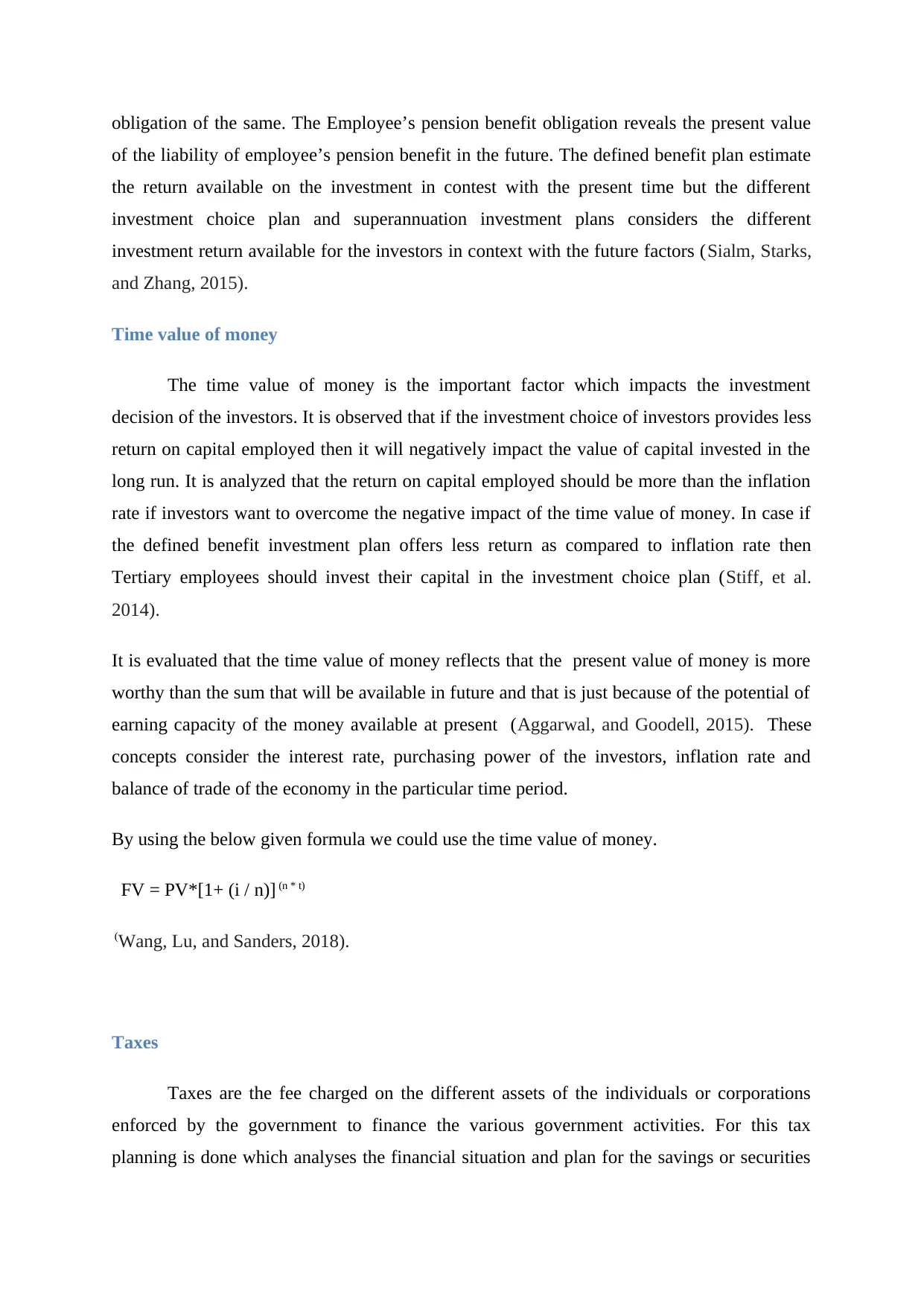
obligation of the same. The Employee’s pension benefit obligation reveals the present value
of the liability of employee’s pension benefit in the future. The defined benefit plan estimate
the return available on the investment in contest with the present time but the different
investment choice plan and superannuation investment plans considers the different
investment return available for the investors in context with the future factors (Sialm, Starks,
and Zhang, 2015).
Time value of money
The time value of money is the important factor which impacts the investment
decision of the investors. It is observed that if the investment choice of investors provides less
return on capital employed then it will negatively impact the value of capital invested in the
long run. It is analyzed that the return on capital employed should be more than the inflation
rate if investors want to overcome the negative impact of the time value of money. In case if
the defined benefit investment plan offers less return as compared to inflation rate then
Tertiary employees should invest their capital in the investment choice plan (Stiff, et al.
2014).
It is evaluated that the time value of money reflects that the present value of money is more
worthy than the sum that will be available in future and that is just because of the potential of
earning capacity of the money available at present (Aggarwal, and Goodell, 2015). These
concepts consider the interest rate, purchasing power of the investors, inflation rate and
balance of trade of the economy in the particular time period.
By using the below given formula we could use the time value of money.
FV = PV*[1+ (i / n)] (n * t)
(Wang, Lu, and Sanders, 2018).
Taxes
Taxes are the fee charged on the different assets of the individuals or corporations
enforced by the government to finance the various government activities. For this tax
planning is done which analyses the financial situation and plan for the savings or securities
of the liability of employee’s pension benefit in the future. The defined benefit plan estimate
the return available on the investment in contest with the present time but the different
investment choice plan and superannuation investment plans considers the different
investment return available for the investors in context with the future factors (Sialm, Starks,
and Zhang, 2015).
Time value of money
The time value of money is the important factor which impacts the investment
decision of the investors. It is observed that if the investment choice of investors provides less
return on capital employed then it will negatively impact the value of capital invested in the
long run. It is analyzed that the return on capital employed should be more than the inflation
rate if investors want to overcome the negative impact of the time value of money. In case if
the defined benefit investment plan offers less return as compared to inflation rate then
Tertiary employees should invest their capital in the investment choice plan (Stiff, et al.
2014).
It is evaluated that the time value of money reflects that the present value of money is more
worthy than the sum that will be available in future and that is just because of the potential of
earning capacity of the money available at present (Aggarwal, and Goodell, 2015). These
concepts consider the interest rate, purchasing power of the investors, inflation rate and
balance of trade of the economy in the particular time period.
By using the below given formula we could use the time value of money.
FV = PV*[1+ (i / n)] (n * t)
(Wang, Lu, and Sanders, 2018).
Taxes
Taxes are the fee charged on the different assets of the individuals or corporations
enforced by the government to finance the various government activities. For this tax
planning is done which analyses the financial situation and plan for the savings or securities
Paraphrase This Document
Need a fresh take? Get an instant paraphrase of this document with our AI Paraphraser
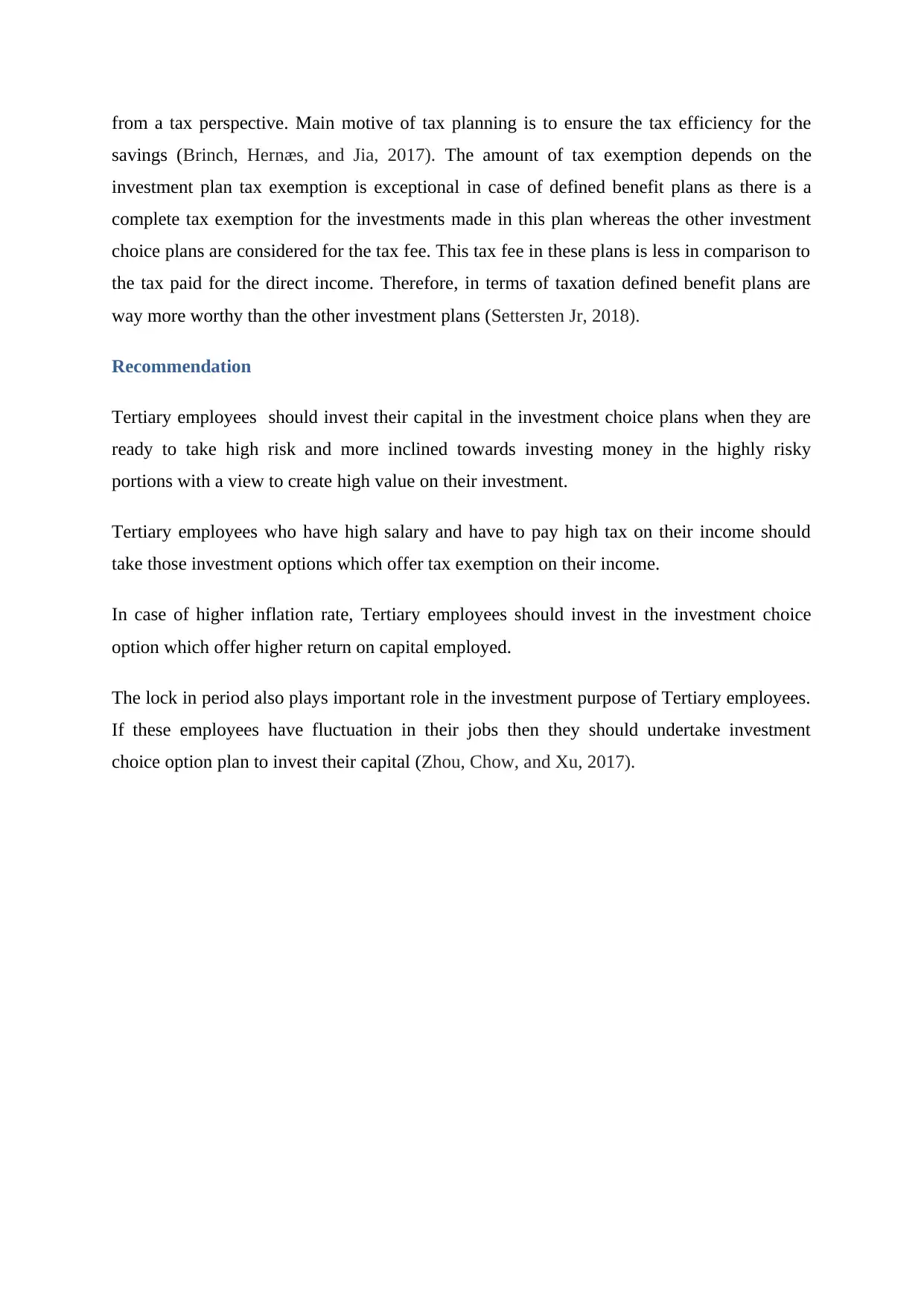
from a tax perspective. Main motive of tax planning is to ensure the tax efficiency for the
savings (Brinch, Hernæs, and Jia, 2017). The amount of tax exemption depends on the
investment plan tax exemption is exceptional in case of defined benefit plans as there is a
complete tax exemption for the investments made in this plan whereas the other investment
choice plans are considered for the tax fee. This tax fee in these plans is less in comparison to
the tax paid for the direct income. Therefore, in terms of taxation defined benefit plans are
way more worthy than the other investment plans (Settersten Jr, 2018).
Recommendation
Tertiary employees should invest their capital in the investment choice plans when they are
ready to take high risk and more inclined towards investing money in the highly risky
portions with a view to create high value on their investment.
Tertiary employees who have high salary and have to pay high tax on their income should
take those investment options which offer tax exemption on their income.
In case of higher inflation rate, Tertiary employees should invest in the investment choice
option which offer higher return on capital employed.
The lock in period also plays important role in the investment purpose of Tertiary employees.
If these employees have fluctuation in their jobs then they should undertake investment
choice option plan to invest their capital (Zhou, Chow, and Xu, 2017).
savings (Brinch, Hernæs, and Jia, 2017). The amount of tax exemption depends on the
investment plan tax exemption is exceptional in case of defined benefit plans as there is a
complete tax exemption for the investments made in this plan whereas the other investment
choice plans are considered for the tax fee. This tax fee in these plans is less in comparison to
the tax paid for the direct income. Therefore, in terms of taxation defined benefit plans are
way more worthy than the other investment plans (Settersten Jr, 2018).
Recommendation
Tertiary employees should invest their capital in the investment choice plans when they are
ready to take high risk and more inclined towards investing money in the highly risky
portions with a view to create high value on their investment.
Tertiary employees who have high salary and have to pay high tax on their income should
take those investment options which offer tax exemption on their income.
In case of higher inflation rate, Tertiary employees should invest in the investment choice
option which offer higher return on capital employed.
The lock in period also plays important role in the investment purpose of Tertiary employees.
If these employees have fluctuation in their jobs then they should undertake investment
choice option plan to invest their capital (Zhou, Chow, and Xu, 2017).
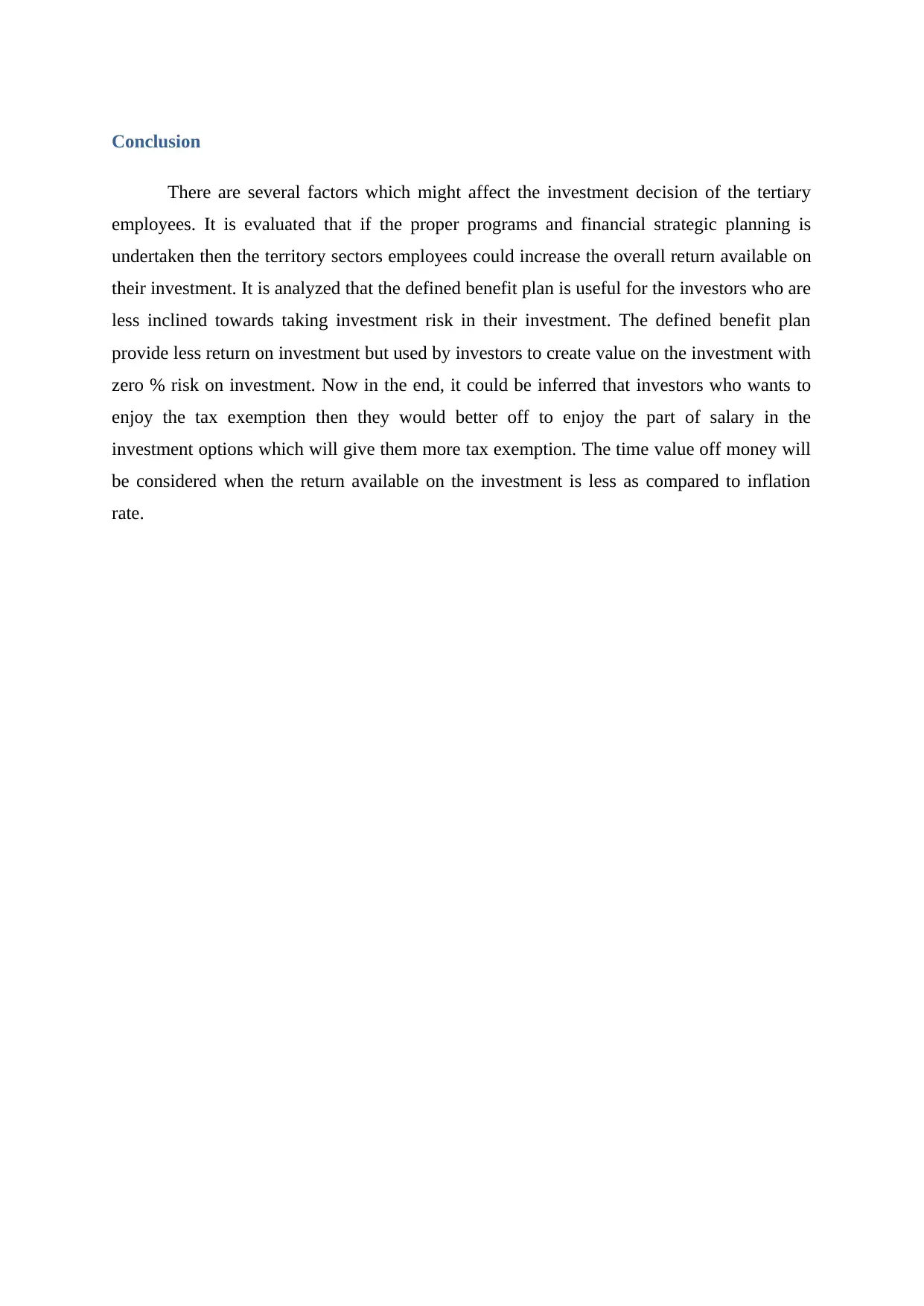
Conclusion
There are several factors which might affect the investment decision of the tertiary
employees. It is evaluated that if the proper programs and financial strategic planning is
undertaken then the territory sectors employees could increase the overall return available on
their investment. It is analyzed that the defined benefit plan is useful for the investors who are
less inclined towards taking investment risk in their investment. The defined benefit plan
provide less return on investment but used by investors to create value on the investment with
zero % risk on investment. Now in the end, it could be inferred that investors who wants to
enjoy the tax exemption then they would better off to enjoy the part of salary in the
investment options which will give them more tax exemption. The time value off money will
be considered when the return available on the investment is less as compared to inflation
rate.
There are several factors which might affect the investment decision of the tertiary
employees. It is evaluated that if the proper programs and financial strategic planning is
undertaken then the territory sectors employees could increase the overall return available on
their investment. It is analyzed that the defined benefit plan is useful for the investors who are
less inclined towards taking investment risk in their investment. The defined benefit plan
provide less return on investment but used by investors to create value on the investment with
zero % risk on investment. Now in the end, it could be inferred that investors who wants to
enjoy the tax exemption then they would better off to enjoy the part of salary in the
investment options which will give them more tax exemption. The time value off money will
be considered when the return available on the investment is less as compared to inflation
rate.
⊘ This is a preview!⊘
Do you want full access?
Subscribe today to unlock all pages.

Trusted by 1+ million students worldwide
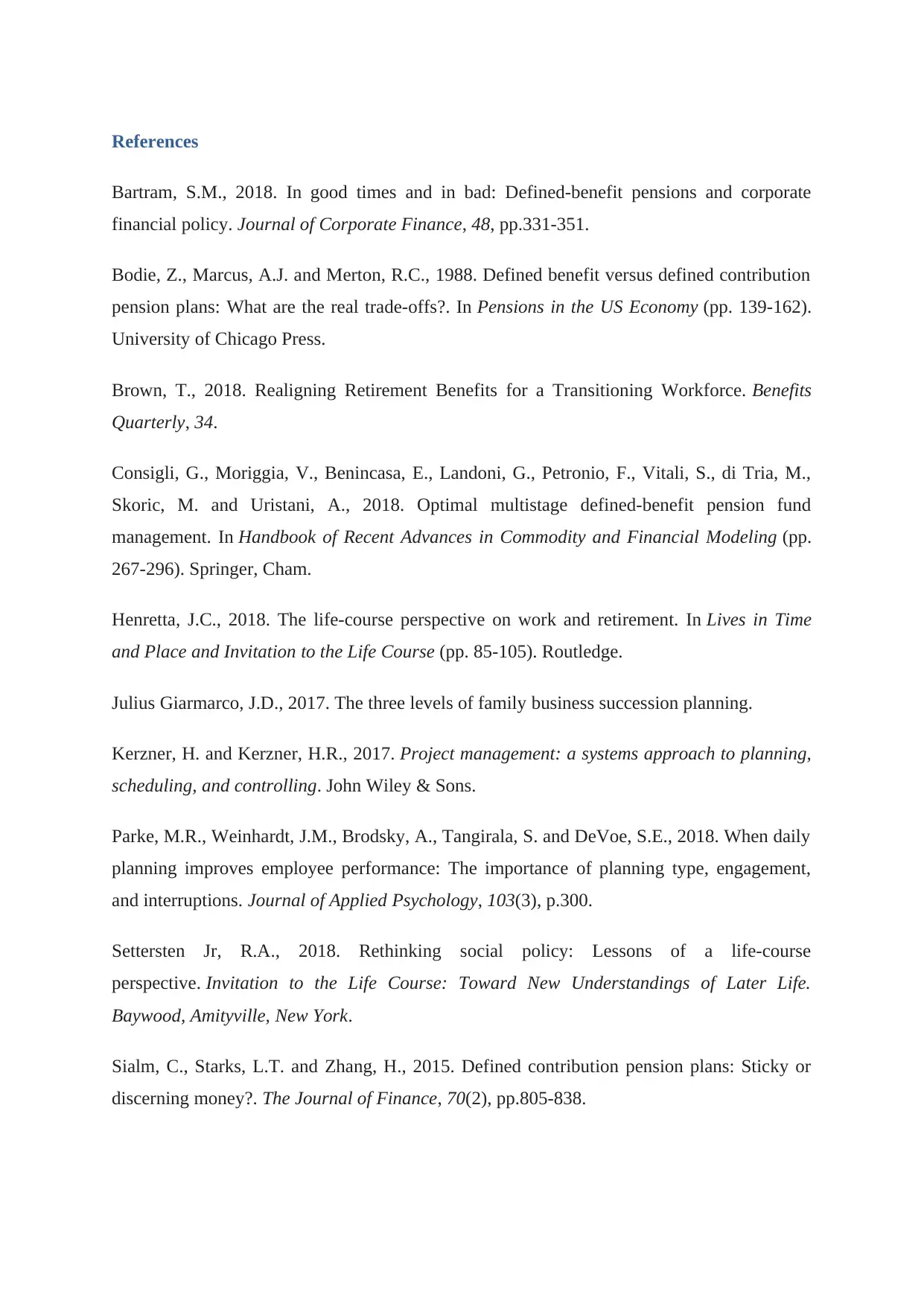
References
Bartram, S.M., 2018. In good times and in bad: Defined-benefit pensions and corporate
financial policy. Journal of Corporate Finance, 48, pp.331-351.
Bodie, Z., Marcus, A.J. and Merton, R.C., 1988. Defined benefit versus defined contribution
pension plans: What are the real trade-offs?. In Pensions in the US Economy (pp. 139-162).
University of Chicago Press.
Brown, T., 2018. Realigning Retirement Benefits for a Transitioning Workforce. Benefits
Quarterly, 34.
Consigli, G., Moriggia, V., Benincasa, E., Landoni, G., Petronio, F., Vitali, S., di Tria, M.,
Skoric, M. and Uristani, A., 2018. Optimal multistage defined-benefit pension fund
management. In Handbook of Recent Advances in Commodity and Financial Modeling (pp.
267-296). Springer, Cham.
Henretta, J.C., 2018. The life-course perspective on work and retirement. In Lives in Time
and Place and Invitation to the Life Course (pp. 85-105). Routledge.
Julius Giarmarco, J.D., 2017. The three levels of family business succession planning.
Kerzner, H. and Kerzner, H.R., 2017. Project management: a systems approach to planning,
scheduling, and controlling. John Wiley & Sons.
Parke, M.R., Weinhardt, J.M., Brodsky, A., Tangirala, S. and DeVoe, S.E., 2018. When daily
planning improves employee performance: The importance of planning type, engagement,
and interruptions. Journal of Applied Psychology, 103(3), p.300.
Settersten Jr, R.A., 2018. Rethinking social policy: Lessons of a life-course
perspective. Invitation to the Life Course: Toward New Understandings of Later Life.
Baywood, Amityville, New York.
Sialm, C., Starks, L.T. and Zhang, H., 2015. Defined contribution pension plans: Sticky or
discerning money?. The Journal of Finance, 70(2), pp.805-838.
Bartram, S.M., 2018. In good times and in bad: Defined-benefit pensions and corporate
financial policy. Journal of Corporate Finance, 48, pp.331-351.
Bodie, Z., Marcus, A.J. and Merton, R.C., 1988. Defined benefit versus defined contribution
pension plans: What are the real trade-offs?. In Pensions in the US Economy (pp. 139-162).
University of Chicago Press.
Brown, T., 2018. Realigning Retirement Benefits for a Transitioning Workforce. Benefits
Quarterly, 34.
Consigli, G., Moriggia, V., Benincasa, E., Landoni, G., Petronio, F., Vitali, S., di Tria, M.,
Skoric, M. and Uristani, A., 2018. Optimal multistage defined-benefit pension fund
management. In Handbook of Recent Advances in Commodity and Financial Modeling (pp.
267-296). Springer, Cham.
Henretta, J.C., 2018. The life-course perspective on work and retirement. In Lives in Time
and Place and Invitation to the Life Course (pp. 85-105). Routledge.
Julius Giarmarco, J.D., 2017. The three levels of family business succession planning.
Kerzner, H. and Kerzner, H.R., 2017. Project management: a systems approach to planning,
scheduling, and controlling. John Wiley & Sons.
Parke, M.R., Weinhardt, J.M., Brodsky, A., Tangirala, S. and DeVoe, S.E., 2018. When daily
planning improves employee performance: The importance of planning type, engagement,
and interruptions. Journal of Applied Psychology, 103(3), p.300.
Settersten Jr, R.A., 2018. Rethinking social policy: Lessons of a life-course
perspective. Invitation to the Life Course: Toward New Understandings of Later Life.
Baywood, Amityville, New York.
Sialm, C., Starks, L.T. and Zhang, H., 2015. Defined contribution pension plans: Sticky or
discerning money?. The Journal of Finance, 70(2), pp.805-838.
Paraphrase This Document
Need a fresh take? Get an instant paraphrase of this document with our AI Paraphraser
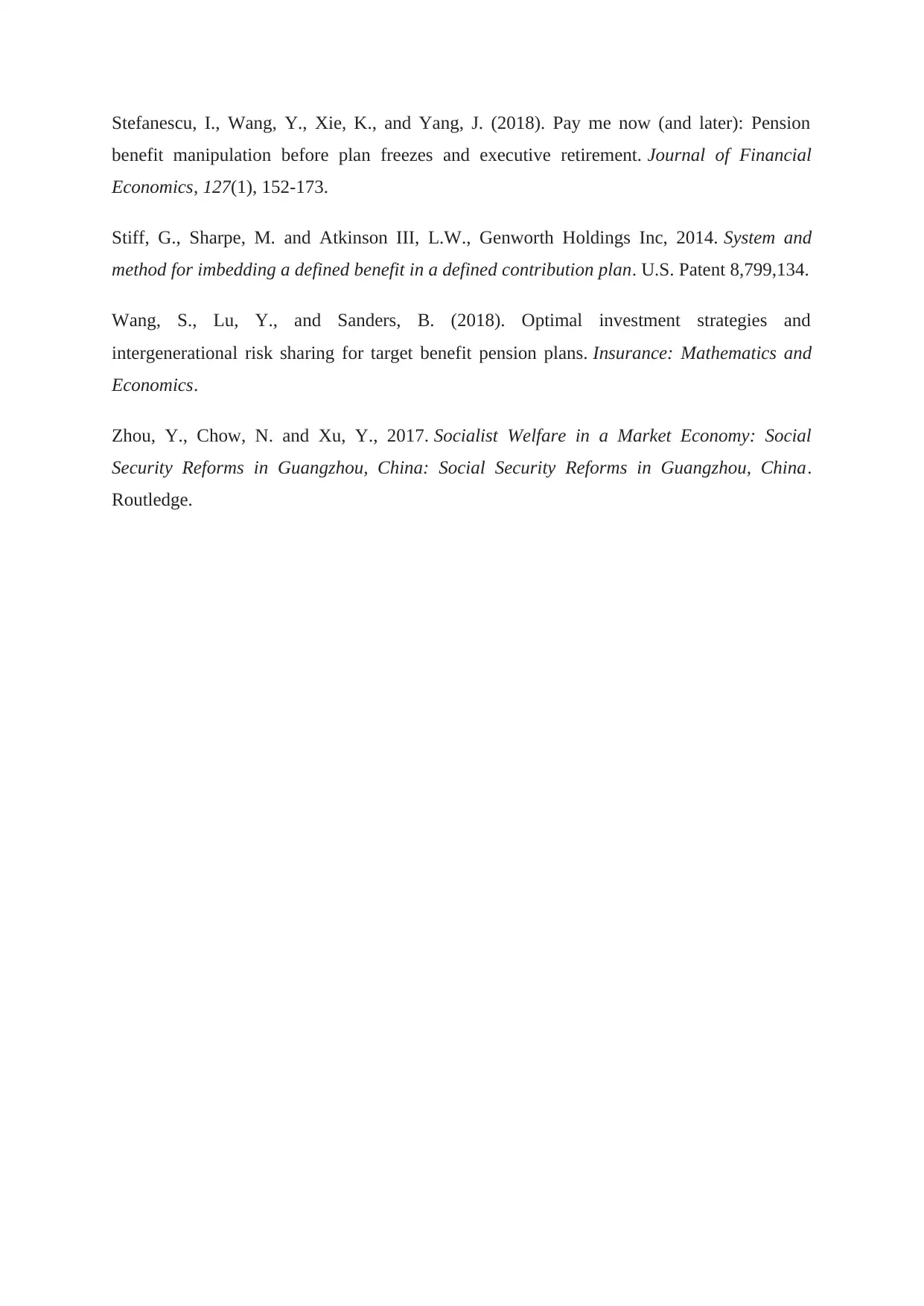
Stefanescu, I., Wang, Y., Xie, K., and Yang, J. (2018). Pay me now (and later): Pension
benefit manipulation before plan freezes and executive retirement. Journal of Financial
Economics, 127(1), 152-173.
Stiff, G., Sharpe, M. and Atkinson III, L.W., Genworth Holdings Inc, 2014. System and
method for imbedding a defined benefit in a defined contribution plan. U.S. Patent 8,799,134.
Wang, S., Lu, Y., and Sanders, B. (2018). Optimal investment strategies and
intergenerational risk sharing for target benefit pension plans. Insurance: Mathematics and
Economics.
Zhou, Y., Chow, N. and Xu, Y., 2017. Socialist Welfare in a Market Economy: Social
Security Reforms in Guangzhou, China: Social Security Reforms in Guangzhou, China.
Routledge.
benefit manipulation before plan freezes and executive retirement. Journal of Financial
Economics, 127(1), 152-173.
Stiff, G., Sharpe, M. and Atkinson III, L.W., Genworth Holdings Inc, 2014. System and
method for imbedding a defined benefit in a defined contribution plan. U.S. Patent 8,799,134.
Wang, S., Lu, Y., and Sanders, B. (2018). Optimal investment strategies and
intergenerational risk sharing for target benefit pension plans. Insurance: Mathematics and
Economics.
Zhou, Y., Chow, N. and Xu, Y., 2017. Socialist Welfare in a Market Economy: Social
Security Reforms in Guangzhou, China: Social Security Reforms in Guangzhou, China.
Routledge.
1 out of 11
Related Documents
Your All-in-One AI-Powered Toolkit for Academic Success.
+13062052269
info@desklib.com
Available 24*7 on WhatsApp / Email
![[object Object]](/_next/static/media/star-bottom.7253800d.svg)
Unlock your academic potential
Copyright © 2020–2025 A2Z Services. All Rights Reserved. Developed and managed by ZUCOL.





